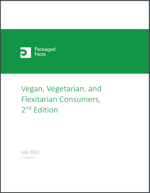 “Plant-based” is the latest buzzword gracing the covers of magazines, cookbooks, and food packaging. However, it would be a mistake to downplay plant-based diets as nothing more than a fad or media hype—plant-based products comprise a fast-growing market with enduring momentum and ongoing investment and innovation.
“Plant-based” is the latest buzzword gracing the covers of magazines, cookbooks, and food packaging. However, it would be a mistake to downplay plant-based diets as nothing more than a fad or media hype—plant-based products comprise a fast-growing market with enduring momentum and ongoing investment and innovation.
The new market research report Vegan, Vegetarian, and Flexitarian Consumers by Packaged Facts uncovers the following key insights into the plant-based market.
1. Since 2017, the U.S. plant-based market has nearly doubled in size and has been growing much more rapidly than the overall food market, according to data jointly released by the Plant Based Food Association (PBFA) and the Good Food Institute (GFI). In 2021, the largest product categories included plant-based milk and plant-based meat, while the fastest growing category was plant-based eggs.
2. More consumers turned to plant-forward diets during the pandemic to support their overall health. Packaged Facts’ May 2022 National Online Consumer Survey indicated that 30% of consumers were still eating more fresh produce than they did pre-pandemic.

3. Most consumers are highly concerned about inflation and the increasing cost of food. In Packaged Facts’ May 2022 survey, 63% of consumers reported being very concerned about rising food prices. Increasing prices for meat are leading some consumers to reduce their consumption of meat or buy less expensive substitutes such as beans and lentils.
4. Flexitarians remain a key target market for plant-based foods because they make up a much larger portion of the population than vegans and vegetarians. (“Flexitarian” is short for “flexible vegetarian,” and is a term used to describe people who follow a semi-vegetarian diet but occasionally eat meat, poultry, or seafood).
5. Vegans, vegetarians, and flexitarians are more likely to be younger in the 18-44 age range encompassing Generation Z and Millennial consumers. Younger consumers are more likely to value healthy, fresh foods and are open to exploring new products. In contrast, the 65 and up age group is the least likely to follow vegetarian or vegan diets.
6. Household income also plays a role in people’s consumption of plant-based foods. Because consumers with higher incomes have the ability to pay for premium foods—such as fresh, whole foods and organic, sustainable, and clean-label products—they are more likely to follow special diets such as veganism or vegetarianism. In addition, people living in urban areas are more likely to consider themselves vegetarian, semi-vegetarian, or vegan. Cities tend to offer more vegan restaurants and plant-based products in stores.
7. Non-white consumer groups tend to be more plant-forward than white consumers, and these groups also tend to skew younger and live in urban settings. Non-white consumers are more likely to follow Hinduism, Islam, and Buddhism, which have some dietary restrictions that may affect consumption of certain animal products.
Find Out More
 To learn more about the state of the plant-based industry in 2022, be sure to read Vegan, Vegetarian, and Flexitarian Consumers, 2nd Edition, the go-to source for a complete understanding of U.S. consumer trends regarding plant-based and plant-forward eating. This report combines Packaged Facts’ extensive monitoring of the food and beverage market with proprietary surveys, and evaluates current trends and future directions for plant-based marketing and retailing, along with consumer patterns during the pandemic and across the broader food and beverage market.
To learn more about the state of the plant-based industry in 2022, be sure to read Vegan, Vegetarian, and Flexitarian Consumers, 2nd Edition, the go-to source for a complete understanding of U.S. consumer trends regarding plant-based and plant-forward eating. This report combines Packaged Facts’ extensive monitoring of the food and beverage market with proprietary surveys, and evaluates current trends and future directions for plant-based marketing and retailing, along with consumer patterns during the pandemic and across the broader food and beverage market.
About Packaged Facts: Packaged Facts publishes market intelligence on a wide range of consumer market topics, including consumer demographics and shopper insights, consumer financial products and services, consumer goods and retailing, and pet products and services. Packaged Facts also offers a full range of custom research services. Reports can be purchased at our company website and are also available through MarketResearch.com.

